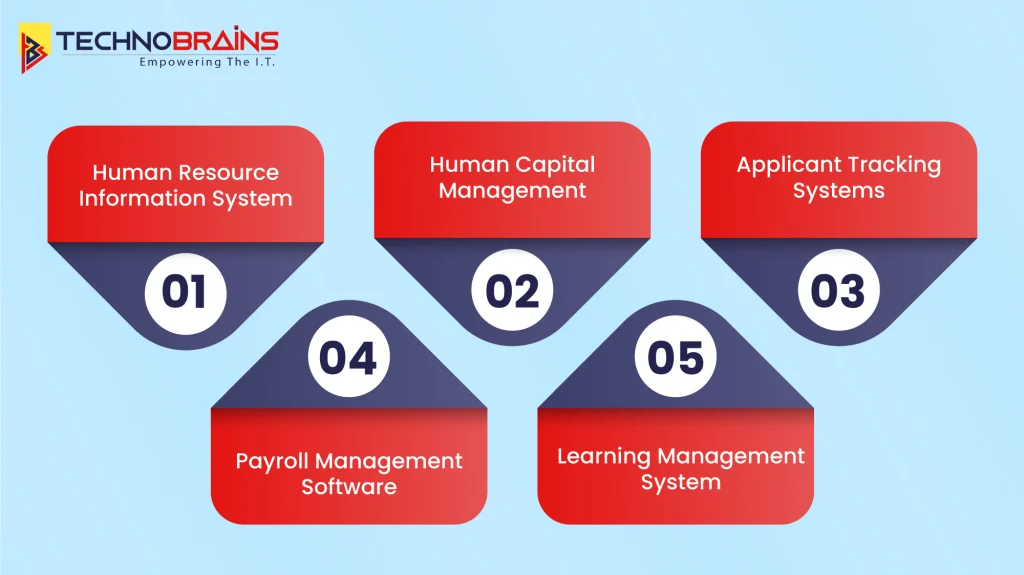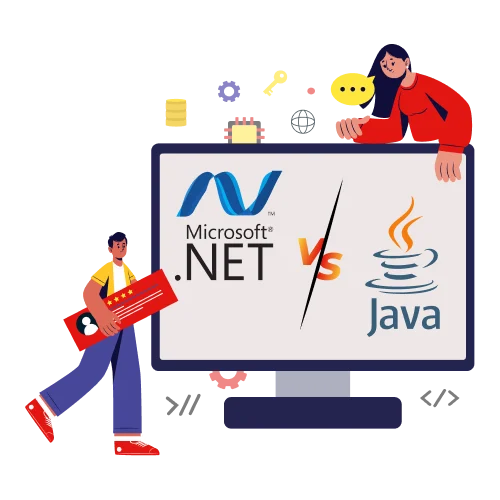HRMS software has now become the backbone on which businesses need to handle and organize their HR functions. A modern-day HRMS solution integrates and automates all the HR functions right from recruitment to payroll. Therefore, understanding the Different Types Of HRMS software is one way to go in finding the most suitable for businesses. Ignoring specific structures, this blog now goes into five significant divisions of HRMS software about how it contributes to organizational success.
Different Types of HRMS Software Development
HRMS software streamlines the operations of HR through tailored solutions. Various Types of HRMS Software Development are mentioned below:

Human Resource Information System:
The human resource information system is the backbone of any HRMS software. It is designed to store and manage all information about employees centrally. HRIS is more administrative, helping the human resources teams to organize workforce data, compliance, and reporting effectively.
Key Features of HRIS:
- Employee Information Management: It allows storing centrally all the employee data regarding their personal information, job description, and performance appraisals.
- Compliance Tracking: Tools to ensure compliance with labour laws and organizational policies.
- Reporting and Analytics: Produce reports on workforce trends, turnover rates, and many more.
Besides helping automate routine administrative tasks, HRIS software frees HR from loads of manual effort and reduces the propensity for errors, thus concentrating their efforts on strategic initiatives.Ideal for small to medium businesses, needing a powerful but intuitive workforce management tool.
Human Capital Management (HCM)
Although HCM software performs the functions of HRIS, it has focused more on strategic planning and developing the workforce. It means that HCM solutions tie talent management strategies with business objectives to maximize “the value of organizational workforces.
Read Also, A Guide to Integration Custom Software with Your Existing Systems
Key Features of HCM Software:
- Workforce Planning Some tools to forecast future workforce needs and proper ways of allocating those resources.
- Talent Acquisition and Retention: Onboarding, recruitment, and employee engagement capabilities.
- Succession planning: It identifies, selects, and develops high potential for leadership positions.
HCM software is particularly used by big organizations in developing a strategy that encompasses people development, productivity, and the growth of the whole organization.
Applicant Tracking Systems (ATS)
Part of the ultimate guide to HRMS software, ATS software creates the outlines for the recruitment task of an HR department by automating job postings, application tracking, and candidate database management.
Key Features of the ATS Software:
- Job Posting and Distribution: Publish your job openings to multiple job boards and social media sites with a single click.
- Resume Parsing: Automatic extraction and categorization of information from resumes for fast analysis.
- Candidate Tracking: Also implements applicant tracking to monitor the status of applicants through the various stages of the hiring process.
ATS software is key for organizations receiving high volumes of applications or that need to manage several job openings in one go, reducing the time-to-hire by making the recruiting process efficient and candidate-friendly.
Payroll Management Software
One of the most sensitive tasks that HR undertakes is the correct processing and dispensation of compensation to employees. The Payroll Management software automates salary calculation, taxation deduction, and benefit distribution in compliance, with reduced administrative burden.
Key Features of Payroll Software:
- Salary Calculations: Automate gross pay and net pay calculations, including bonuses, deductions, and overtime.
- Tax Compliance: Ensure that tax deductions are made correctly and returns are filed on time, according to both local and national laws.
- Direct Deposit: Salaries can be seamlessly transferred into the accounts of employees using in-built payment gateways.
Because this software eliminates all the complexities associated with manual payroll processing, it brings accuracy, time-saving, and lower chances of financial errors, making it indispensable for organizations of all sizes, right from a startup to a large company.
Learning Management System
The development of the employees and continuous learning are of paramount importance to keeping the workforce competitive. The LMS will provide a visualized and accessible platform for employee training, skill development, and compliance certification.
Key Features of LMS Software Include:
- Course Management: Creation, assignment, and tracking of the training programs based on needs. e-Learning Integration: Access to training resources online, videos, and webinars.
- Progress Tracking: Keep track of employee progress and the status of training modules completed.
- Certification Management: Ensure compliance with legal training requirements and issue the necessary certifications about the same.
An LMS equips organizations with a learning environment that not only refines the skills of the personnel within but also retains and engages them. It is peculiarly valuable for industries where regulatory demands are at the highest, such as health and financial services.
Read Also, Ultimate Guide to Developing Human Resource Management Software
Conclusion
The HRMS software space is grand-from addressing human resource issues in a very customized way to dealing with workforce strategy alignment through HCM, recruitment via ATS, payroll automation, or even growth nucleation via an LMS-the gamut runs, and each type of software is used for a specific reason and function in improving the HR function. Most of the selection would depend upon the size of the organization, goals, and specific HR challenges. Proper investment in the right HRMS tools will help businesses not only streamline their HR processes but also result in an engaged, productive, and satisfied staff. Are you seeking HRMS Software Development services then consider TechnoBrains.
Still stuck with questions? Contact Us today and get all your solutions here.







